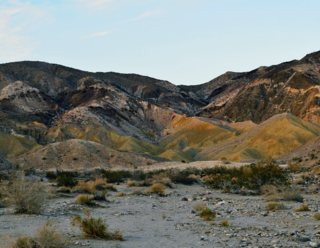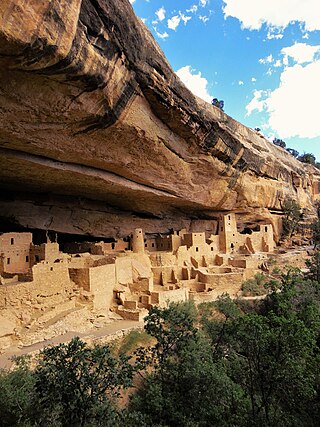
Coquina is a sedimentary rock that is composed either wholly or almost entirely of the transported, abraded, and mechanically sorted fragments of mollusks, trilobites, brachiopods, or other invertebrates. The term coquina comes from the Spanish word for "cockle" and "shellfish".

City Island, Daytona Beach, Florida, United States, is an island in the Halifax River between mainland Florida and the barrier islands/outer banks. Buildings on the island include the Daytona Tortugas' Jackie Robinson Ballpark, the city's courthouse, and the main branch of the Volusia County Library.

The Denver Basin, variously referred to as the Julesburg Basin, Denver-Julesburg Basin, or the D-J Basin, is a geologic structural basin centered in eastern Colorado in the United States, but extending into southeast Wyoming, western Nebraska, and western Kansas. It underlies the Denver-Aurora Metropolitan Area on the eastern side of the Rocky Mountains.
The Floridan aquifer system, composed of the Upper and Lower Floridan aquifers, is a sequence of Paleogene carbonate rock which spans an area of about 100,000 square miles (260,000 km2) in the southeastern United States. It underlies the entire state of Florida and parts of Alabama, Georgia, Mississippi, and South Carolina.
Surficial aquifers are shallow aquifers typically less than 50 feet (15 m) thick, but larger surficial aquifers of about 60 feet (18 m) have been mapped. They mostly consist of unconsolidated sand enclosed by layers of limestone, sandstone or clay and the water is commonly extracted for urban use. The aquifers are replenished by streams and from precipitation and can vary in volume considerably as the water table fluctuates. Being shallow, they are susceptible to contamination by fuel spills, industrial discharge, landfills, and saltwater. Parts of southeastern United States are dependent on surficial aquifers for their water supplies.

Blowing Rocks Preserve is an environmental preserve on Jupiter Island in Hobe Sound, Martin County, Florida, USA. Owned by The Nature Conservancy, it contains the largest limestone outcropping on the state's east coast, part of the Anastasia Formation. Breaking waves spray plumes of water up to 50 feet (15 m) in height through erosional holes, hence the moniker blowing rocks; this distinctive spectacle thus earned the limestone outcrop's name. The limestone outcropping also encompasses coquina, crustaceans, and sand, protruding visibly from the beach.

The Coyote Mountains are a small mountain range in San Diego and Imperial Counties in southern California. The Coyotes form a narrow ESE trending 2 mi (3.2 km) wide range with a length of about 12 mi (19 km). The southeast end turns and forms a 2 mi (3.2 km) north trending "hook". The highest point is Carrizo Mountain on the northeast end with an elevation of 2,408 feet (734 m). Mine Peak at the northwest end of the range has an elevation of 1,850 ft (560 m). Coyote Wash along I-8 along the southeast margin of the range is 100 to 300 feet in elevation. Plaster City lies in the Yuha Desert about 5.5 mi (8.9 km) east of the east end of the range.

The Avon Park Formation is a Middle Eocene geologic formation and is the oldest exposed sediments in Florida, United States.

The Ogallala Formation is a Miocene to early Pliocene geologic formation in the central High Plains of the western United States and the location of the Ogallala Aquifer. In Nebraska and South Dakota it is also classified as the Ogallala Group. Notably, it records the North American Land Mammal Ages (NALMAs) Hemphillian, Clarendonian, and Barstovian. It also includes an excellent record of grass seeds and other plant seeds, which can be used for biostratigraphic dating within the formation. The Ogallala Formation outcrops of Lake Meredith National Recreation Area preserve fish fossils. Similar specimens from the same unit are found at Alibates Flint Quarries National Monument in Texas.

The Boquillas Formation is a geologic formation deposited during the Late Cretaceous in modern-day West Texas. It is typically composed of alternating marls and limestones with thin volcanic ash beds (bentonites). It was named for outcrops near the former Boquillas post office in Big Bend National Park. The term Boquillas Formation has been used for rocks that outcrop from Del Rio, Texas to as far west as Doña Ana County, New Mexico.
The Hannold Hill Formation is an Early Eocene (Wasatchian) geologic unit in the western United States. It preserves the fossilized remains of the ray Myliobatis and gar.

The Cliff House Sandstone is a late Campanian stratigraphic unit comprising sandstones in the western United States.
The Fernando Formation is a Plio-Pleistocene marine mudstone, siltstone and sandstone formation in the greater Los Angeles Basin, Ventura Basin, and Santa Monica Mountains, in Los Angeles County of Southern California.
The Pico Formation is a Pliocene epoch stratigraphic unit and geologic formation in the greater Los Angeles Basin, the Santa Monica Mountains, and the Santa Susana Mountains, in Los Angeles County of Southern California.

The Key Largo Limestone is a geologic formation in Florida. It is a fossilized coral reef. The formation is exposed along the upper and middle Florida Keys from Soldier Key to the Bahia Honda Channel. The islands form a long narrow arc concentric with the inner edge of the Florida Straits and with the Florida Reef. The limestone includes fossils of corals, mollusks and bryozoans. Fossilized coral head formations are visible in some exposures. The Key Largo Limestone continues in a narrow band underwater just offshore of the coast of Florida north of Soldier Key to the middle of the Palm Beach County coast, and southward just offshore of the lower Florida Keys to the Dry Tortugas.

The Miami Limestone, originally called Miami Oolite, is a geologic formation of limestone in southeastern Florida.
The geology of Nebraska is part of the broader geology of the Great Plains of the central United States. Nebraska's landscape is dominated by surface features, soil and aquifers in loosely compacted sediments, with areas of the state where thick layers of sedimentary rock outcrop. Nebraska's sediments and sedimentary rocks lie atop a basement of crystalline rock known only through drilling.

The geology of Virginia began to form 1.8 billion years ago and potentially even earlier. The oldest rocks in the state were metamorphosed during the Grenville orogeny, a mountain building event beginning 1.2 billion years ago in the Proterozoic, which obscured older rocks. Throughout the Proterozoic and Paleozoic, Virginia experienced igneous intrusions, carbonate and sandstone deposition, and a series of other mountain building events which defined the terrain of the inland parts of the state. The closing of the Iapetus Ocean, to form the supercontinent Pangaea added additional small landmasses, some of which are now hidden beneath thick Atlantic Coastal Plain sediments. The region subsequently experienced the rifting open of the Atlantic Ocean in the Mesozoic, the development of the Coastal Plain, isolated volcanism and a series of marine transgressions that flooded much of the area. Virginia has extensive coal, deposits of oil and natural gas, as well as deposits of other minerals and metals, including vermiculite, kyanite and uranium.
The Algoa Group is one of five geological groups which comprise the coastal Cenozoic geological deposits in South Africa. The Algoa Group contains six formations which range from Middle Eocene to Late Holocene in age.
The Atlantic Coastal Ridge is a geomorphological feature paralleling the Atlantic coast of Florida from the border with Georgia to Miami-Dade County, where it transitions into the Miami Rock Ridge. For most of its length it consists of one or more relict beach ridges created when the sea level was about 30 feet (9.1 m) higher than at present. The southernmost part of the Atlantic Coastal Ridge was created as a carbonate platform during the same period. Before human modification for agriculture and urban development, much of the ridge hosted scrub vegetation.













